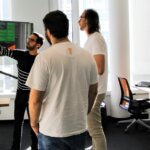How to build digital twins for supply chain

|
Getting your Trinity Audio player ready...
|
Getting to grips with supply chain dynamics and understanding what’s happening inside a black hole may seem unrelated, but it turns out that the two topics share some common ground. Both are challenging problems to solve. However, a more intriguing similarity centers around the deployment of digital twins, which can be defined as software models, or virtual replicas, of real-world processes and operations. Digital twins are useful research tools, and their popularity is on the rise in industrial sectors too. Examples covered previously on TechHQ include uses in aerospace, which enable predictive maintenance of jet engines. And now we’re turning our attention to how to build digital twins to model supply chain issues.
As a PhD student at Harvard University, US, Bob Rogers spent his time studying pencil-thin beams of light emitted in outer space – reverse engineering the astrophysical data to infer conditions inside black holes. And to do that, he built digital twins. The software models allowed him to dial up various black hole parameters to generate virtual results that closely matched the emissions observed in real life. Those analytical skills – which included using machine learning tools and data science techniques – have served him well in various roles, from quantitative finance to using artificial intelligence (AI) in healthcare. And today, as CEO and co-founder of Oii, Rogers is helping to build digital twins to solve one of the biggest headaches facing global business – managing supply chains.
Scenario planning
“We feed digital twins of the supply chain with situations that we think it needs to be prepared for,” he told TechHQ. “And this allows us to play out thousands of different scenarios.” Oii isn’t trying to predict the future – firms already have their own forecasting models. Instead, Rogers and his team are interested in how variable the future could be and show how building digital twins for supply chain can examine the capacity of each node in the network to handle those fluctuations.
Running the models, clients can determine what the actual demand signals are and take steps to identify bottlenecks. “It can be a single rate-limiting step, but sometimes we see that a lot of material is going downstream to the wrong places,” Rogers explained. “[Having a digital twin of the supply chain] allows you to massage each point so that all parts are working in harmony.”
Firms can adjust model parameters to signpost savings on warehouse capacity and pinpoint other opportunities for lifting profits. But companies are using digital twins of supply chain operations in other ways too. For example, users are optimizing their models for carbon to determine ways of lowering industrial greenhouse gas emissions. Rogers revealed that one client applied double multipliers to make sure that it was emphasizing environmental signals when running its software model of real-world processes.
To get up and running, clients feed data from invoices, spreadsheets, and other business intelligence into Oii’s adaptive extract, transform, and load (ETL) pipeline. As the tool ingests customer data, it uses machine learning to classify the data types and map the information to different parts of a backend cognitive modeling algorithm. “The system builds up a picture of how a product is made and flows through to customers,” said Rogers.
READ NEXT

AI digests supply chain risk
The ETL pipeline carries out other checks as well, which include industry benchmarking to gauge the quality of data being ingested. And the mapping process quickly exposes any sub-optimal areas that need to be bolstered with more accurate or representative information. The flip side, when company data scores highly, is that user confidence in their business intelligence rises, unblocking decisions that may have stalled in the past.
For users, understanding how to build digital twins for supply chain operations can generate some huge wins for companies. Rogers shares an example of a food manufacturer that was able to reduce inventory by 32%, bringing major cost-savings in warehousing, and add 14 days to the shelf life of products through streamlined operations. And even when processes have been optimized, digital twins can still add value to the business.
Turning point for digital twins
“Digital twins can adapt to change,” Rogers points out. “It’s like going from a printed map to using turn-by-turn navigation.” The confluence of big data, scalable compute, and readily available AI algorithms creates an ideal information processing ecosystem for the global business community to benefit more widely from digital twins. When disruption occurs, users can simulate possible solutions such as adding a new hub or relocating manufacturing operations to determine the optimal strategy. And operators can prepare in advance by training models on synthetic data.
Oii is just one of a number of firms developing digital twins for supply chain applications. Coupa provides a supply chain modeler to help business leaders make better decisions that strike the right balance of profitability, service, sustainability, and risk. And AnyLogic has supply chain software – dubbed anyLogistix – to tackle a range of business challenges, including transportation planning and sourcing optimization.
Today, thanks to advances in how to build digital twins for supply chain applications, the prospects for global businesses to navigate future disruption and raise their environmental performance are strong.









